
It has been nearly ten years since I designed the "new" air conditioning system for Lubbock High School. This was the prestige project from the 1989 bond issue. Before then few school buildings were air conditioned. The citizens of Lubbock had voted more than 58 million dollars in bonds for school improvements, their largest school bond election ever. I had worked with Harold Glasscock to develop the air conditioning budgets for all the schools in town, so I knew what I was getting into. Without a crystal ball though, I could not foresee that Knox, Gailey, and Meador would be awarded the contract on bid on just under two million dollars, or that it would be the last hurrah for the quintessential gentleman tinner, G. O. Hill.
Players in this drama would include my friend and client, eminent Lubbock architect C. Berwyn Tisdel, and Byron Martin, the legendary Lubbock general contractor who came out of retirement to oversee the bond projects. Both were graduates of the school. Byron's diploma was dated 1945 and Berwyn was in a class a few years later. At our first design meeting the first question they asked was, "How are you going to air condition Lubbock High?" It would be weeks before I was ready to answer that question.

I knew generations of Westerners would be looking over my shoulder to make sure I did not defile their alma mater. If that were not enough, the campus had been entered in the National Register of Historic Places, a unique designation in Lubbock. This project promised to be one of the highlights of my career as a consulting engineer.
Looking back on it now, it certainly was. I recently paid a return visit to my ten year old job. Lubbock High is just as impressive as it ever was. For one thing, the building is huge. It solidly fronts two city blocks on nineteenth street, more than a block deep, and three stories high.
The architectural style is Romanesque. A bell tower is the focal point. Two open courtyards separate the central auditorium from the classroom wings. The roof is richly colored dark red glazed barrel tile. The brick, rougher in texture than modern firings, has a decided gold tint to the buff color. They are laid in intricate geometric patterns around arches, at the roofline and elsewhere.
The surprising element is the masonry ornamentation of terra cotta. Used liberally, with a subtle color shift even more toward a gold hue, the glazed surface visually separates the detailed relief sculptures from the brickwork. I cannot emphasize enough the visual impact of the terra cotta. As durable as it is beautiful, it was used far more than I expected. There is no deterioration or fading after seventy years. Besides the decorative turrets, plaques, and sculptured figures, terra cotta is used for banisters, handrails, functional grillwork and massive frames around the porticos.

The copper downspouts, now weathered to a deep chocolate patina and the matching window frames complete the major color scheme. Highlights of glazed ceramic tile create colorful points of interest at strategic locations, such as porches and vestibules.
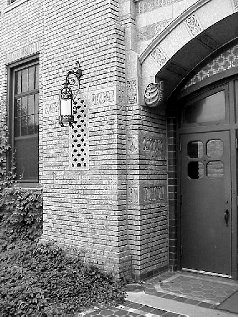
There are delicious little surprises in the construction details, like icons depicting the academic disciplines, wrought iron gates, and external fire escapes reminiscent of a bygone era.
.
.
.
The building is art.
Art to learn in.
Art to teach in.
Art to glory in.
The details, too, are art.
Art to appreciate.
Art to admire.
Art to enjoy.
.
.
.

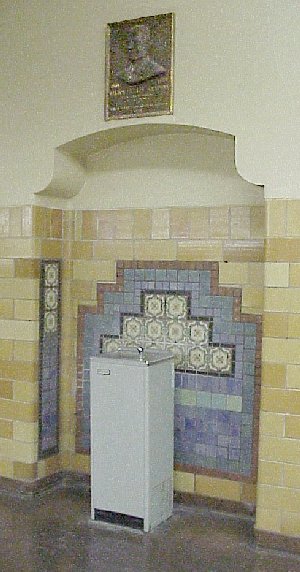
Inside the building, a few changes have been made to the classrooms over the years. Acoustic lay-in ceilings were installed in 1964. Incandescent lighting was replaced with fluorescent lighting more suitable for the teaching mission. Other than that, the original design is virtually intact. The guardians of her architectural heritage have obviously been manning the ramparts. The walls are metal lath and plaster with high glazed block wainscot. The flooring is battleship linoleum that has been replaced just once. The trophy cases, filled with accomplishments from the better part of a century, look to be a mile long. (I noticed the spurs prominently displayed.) There are beautiful Spanish tile alcoves for the drinking fountains. Bronze memorial plaques, painted murals, and portraits of Lubbock's heroes of education adorn the walls. There are paintings by Milosevich, Hurd, Kincaid, Gore, and others.
***
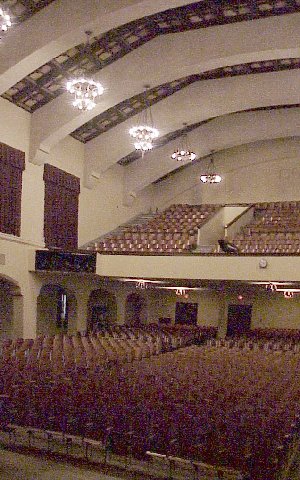
The auditorium is the most elaborate space in the building. There is a true performance stage, a lobby, and a balcony. The ceiling is patterned tile between deep beams. The windows have blackout curtains for light control. House lights are chandeliers on winch operated cables which can be lowered for relamping
As I walked through the mostly empty building, teachers were preparing for the start of a new school year. I spoke with grateful teachers who remembered the sweltering summer heat in the days before air conditioning. I remembered too, and in my mind relived the design process.
From the dusty archives of the maintenance office I got the original blueprints for the building. They were old and crinkled, torn and taped up at the edges. They had been drafted in intricate detail using ink-on-linen, now a lost art in this town. It conjured up a mental image of an old-time draftsman with arm garters and a green eye-shade on a tall drafting stool hunched over his drafting board. The tracing would have been thumb-tacked to the big drafting board and his tools would have been a T-square, scale, compass, triangles, a few pens, and a smoldering cigarette to dry the ink.
Peters, Strange, and Bradshaw were the architects for Lubbock High, all long since dead. They say Mr. Strange wanted on his tombstone "Here lies an honest architect." People would look at it and say "Thatís Strange!"
I took stock of what I had to work with. "Good passive design," I thought, "Lots of mass in the masonry construction, high ceilings, operable windows, and cross ventilation." Some relief from the hot summer weather could be felt by opening the windows. It was not bad in the morning, especially if a breeze was blowing. Cool nights and low humidity helped. Of course, school was out for the hottest part of the summer, so they got by.
.

In the winter, heat was provided by a vacuum steam heating system. It was state-of-the-art back in 1930. The low-pressure steam boilers had been coal fired, but were later converted to burn natural gas. The boiler inspector had not red-tagged the old boilers, but the school had been warned. They were nearly old enough to draw social security.

.
.
.
The boilers supplied steam to the classroom radiators through bare pipes. A vacuum heating pump collected the condensate and injected it back into the boilers. The good news was that the steam and condensate piping was in a crawl space under the first floor and it was in serviceable condition.
Hand valves on the radiators controlled the temperature in the room. It was simple, efficient, silent, and reliable. I briefly considered leaving all the classroom radiators intact, but it was a fleeting whimsy.
The old building seemed to talk to me. She said, "I may look like a museum piece, but I am not! Listen to what my teachers are saying. Look at the courses they are teaching. Look at what is written on my chalkboards. Look at what's plugged into my electrical sockets. Look at my bright young students. I may be from the past, but I must be a part of the future. Design an air conditioning system worthy of me." The gauntlet had been thrown down by both Beauty and Function. The challenge was clear: both demanded satisfaction.
My client was growing impatient for the answer to the first question asked. I took all the time I needed. This building, perhaps more than any other, was the soul of Lubbock, Texas. I was in no humor to propose three alternate designs and let a committee of laymen choose one of them. I ignored equipment salesmen offering to "help" me design. (ie. influencing specifications). I would take only my best shot on this job.
The answer turned out to be as complex as the building itself, but the key was the individual classroom. There, the most obvious solution was the best one. Where possible, I would just replace the old steam heat radiators with modern terminal devices capable, on demand, of heating, cooling, ventilating, filtering, dehumidifying, and thermostatic temperature control.

The trades called this a "4-pipe" system. I would specify heavy-duty terminals of the unit ventilator class. When properly applied, these devices are quiet, durable, and energy efficient. With furniture grade cabinets, they also looked good. They would have chilled water coils for cooling, and steam coils for heating. The existing steam distribution pipes could be used and we would parallel them with new insulated pipes for the 45 degree circulating chilled water.
Of course, every room was a special case, and this scheme had to be adapted to fit. Some units had to be ceiling mounted. Others could be concealed in the attic. Where there were no steam lines, I used circulating hot water for heat.
The decision about air conditioning the very public corridors was actually the easiest part of the design. I would simply do nothing to the halls. They were already heated by steam radiators. Radiators visually time-dated the building and were part of her charm. That would solve the appearance problem, but would it work? I rationalized that the halls were not teaching spaces and were occupied only briefly during class change. The key factor was the design of the building for cross-ventilation. The transom over the door allowed some cooling from the classrooms to migrate into the corridor. The plan subsequently proved to work reasonably well.
.
The Auditorium is the other very public space. Any new equipment would have to be concealed, at least where the audience could not see it. Fortunately, the auditorium had been designed from the beginning with central forced air heating and ventilation. Refrigerated cooling coils could be added to that system to take care of two thirds of the load, and there was space under the balcony to conceal a couple of new air handlers for the remainder.

By this time, volumes of thermodynamic calculations told the story. My psychometric analysis was complete. I was looking at more than 500 tons of refrigeration. Nothing less than a central plant with circulating chilled water would do for that. I specified two centrifugal water chillers, 250 tons each. They would just fit in the old coal bin. I integrated a waterside economizer into the piping network to provide free cooling when the outside wet bulb temperature was low enough.
The yard outside the mechanical room was excavated down to basement floor level and the north wall was removed to get the new chillers into the building. We took an alternate bid to replace the old boilers while we had the opening. Fortunately, the bids were very competitive, and we were able to get new boilers within the budget.
The gym and band hall had flat roofs which allowed the use of roof mounted equipment, so I did. This package equipment could be used independently of the central chillers in the summer and that seemed to be a good idea.
Still, I had to have some space to put the cooling towers. There was a small fenced alcove behind the auto shop on the backside of the building, a three car wrecking yard.

The auto mechanics class was moving to another site, so I put the cooling towers in the wrecking yard. They can be seen, but only from the rear parking lot. They may even look better than the wrecked cars.
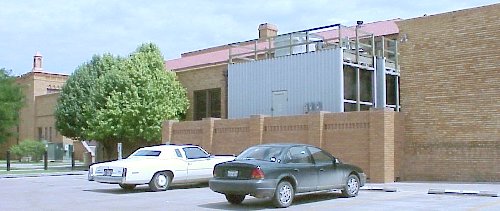
.
..
.
.
When I briefed Berwyn Tisdel and Byron Martin on my plan, they nodded approval. I could turn loose my staff to work out the details and draft the job. We drew the project at 1/16" scale on E size (30"x42") sheets. It took 42 sheets.
We used the PegAEsys CAD (Computer Aided Design) software we had written ourselves. The big VAX computer purred softly in the next room as the image of the boiler room came up on the screen of the Tektronix terminal. Just for a moment, I imagined I was Strange. The blue linen tracing was tacked down on my big drafting board under my T-square. I had just laid down a thick black line representing a steam pipe. I wiped the India ink from the K&E ruling pen and laid it aside. I took a drag on my Chesterfield, flicked the ash, and curled the coal a half inch above the wet ink to dry it. I swiveled around on the drafting stool and looked out the north window toward the court house square at a young Lubbock. I thought, "How fortunate I am to be designing the prestige job of 1930."
My reverie ended, but the thought persisted.
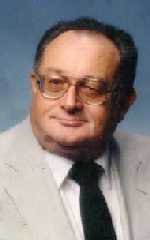 I
wish to thank John McCracken, formerly head of LISD maintenance, for his
help in researching this article. Thanks also to Tom Dabov, architectural
historian and friend, for his advise. And much obliged to the contractors
whose craftsmanship made this engineer look good. This is my picture from
the year I designed the project. Barto Fanning
I
wish to thank John McCracken, formerly head of LISD maintenance, for his
help in researching this article. Thanks also to Tom Dabov, architectural
historian and friend, for his advise. And much obliged to the contractors
whose craftsmanship made this engineer look good. This is my picture from
the year I designed the project. Barto Fanning
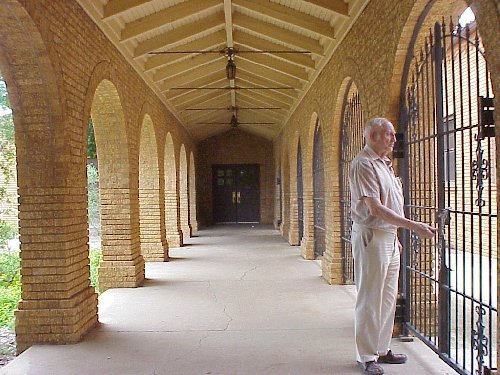 .
.
John McCracken

The Cover:
A mural of the Westerner hangs in the corridor of Lubbock High School. It is dated 1949 and signed "Gore".
.
Shown here is just the center part of that mural. To the right is the caprock. To the left a wagon train is off in the distance.
.
We have not been able to find any information about the origin of the painting. The art is outstanding, and we regret we cannot give the artist appropriate credit.
.
.
.
.
.
EPILOG

Room 123 was the homeroom of Buddy Holly, Lubbock's rock and roll legend. His picture hangs in the hall. There is also a sign out on the street to let to let his legions of fans from all over the world know this was Buddy's high school.
.
.
.
.
.
*
Additions were made to Lubbock High School in 1942 and 1949 by successor firms Haynes and Strange, and later, Haynes and Kirby. Unfortunately, administrative offices have been constructed in the west courtyard. Behind the arcade, they are not visible to the public, but the symmetry of the building is compromised. I knew "Pappy" Haynes and Laverne Kirby. The Hemphill-Wells Building (1948), Textile Engineering at Tech, and The Lubbock Coliseum-Auditorium (1955) were among other building they designed I would update through the years.
*
Lubbock High is a living legend with an international reputation for ground breaking innovation: LEAP, magnet programs, and now the International Baccalaureate Diploma Certification, the ISO9000 equivalent for education. The gallery of photos in the administrative waiting room reads like the Who's Who of Lubbock Independent School District.
*
Doyle Vogler is the new principal for next year, but he has been at Lubbock High about as long as the air conditioning. He is a young man with a mission, and the vision to pull it off. Hello, 21st century. Lubbock High is ready for you!
*